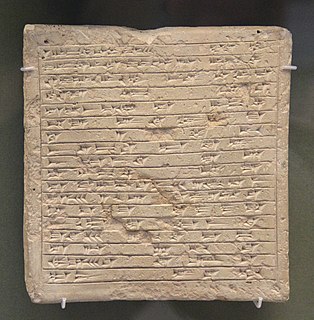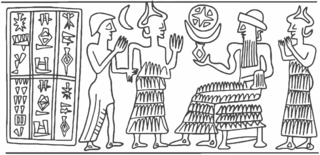Related Research Articles

Assyria was a major ancient Mesopotamian civilization which existed as a city-state from the 21st century BC to the 14th century BC and then as a territorial state and eventually an empire from the 14th century BC to the 7th century BC.
Shalmaneser IV was the king of the Neo-Assyrian Empire from 783 BC to his death in 773 BC. Shalmaneser was the son and successor of his predecessor, Adad-nirari III, and ruled during a period of Assyrian decline from which few sources survive. As such his reign, other than broad political developments, is poorly known. Shalmaneser's time was marked both by an increase in the power held by Assyrian officials relative to that of the king and Assyria's enemies growing increasingly powerful. Most of Shalmaneser's military efforts were spent warring against the Kingdom of Urartu in the north, which during this time was reaching the peak of its power.

Ashur-uballit I(Aššur-uballiṭ I), who reigned between c. 1363 and c. 1328 BC, was the first king of the Middle Assyrian Empire. After his father Eriba-Adad I had broken Mitanni influence over Assyria, Ashur-uballit I's defeat of the Mitanni king Shuttarna III marks Assyria's ascendancy over the Hurri-Mitanni Empire, and the beginning of its emergence as a powerful empire. Later on, due to disorder in Babylonia following the death of the Kassite king Burnaburiash II, Ashur-uballit established Kurigalzu II on the Babylonian throne, in the first of what would become a series of Assyrian interventions in Babylonian affairs.

Sargon I was the king during the Old Assyrian period from c. 1920 BC to 1881 BC. On the Assyrian King List, Sargon appears as the son and successor of Ikunum, and the father and predecessor of Puzur-Ashur II.
Ashur-nadin-ahhe II(Aššur-nādin-ahhē II) was king of Assyria from c. 1400 to 1391 BC. Preceded by Ashur-rim-nisheshu, he was succeeded by his brother, Eriba-Adad I.
Ashur-etil-ilani, also spelled Ashur-etel-ilani and Ashuretillilani, was the king of the Neo-Assyrian Empire from the death of his father Ashurbanipal in 631 BC to his own death in 627 BC. Ashur-etil-ilani is an obscure figure with a brief reign from which few inscriptions survive. Because of this lack of sources, very little concrete information about the king and his reign can be deduced.
Ashur-nirari V was the king of the Neo-Assyrian Empire from 755 BC to his death in 745 BC. Ashur-nirari was a son of Adad-nirari III and succeeded his brother Ashur-dan III as king. He ruled during a period of Assyrian decline from which few sources survive. As such his reign, other than broad political developments, is poorly known.
Ashur-dan III was the king of the Neo-Assyrian Empire from 773 BC to his death in 755 BC. Ashur-dan was a son of Adad-nirari III and succeeded his brother Shalmaneser IV as king. He ruled during a period of Assyrian decline from which few sources survive. As such his reign, other than broad political developments, is poorly known. At this time, the Assyrian officials were becoming increasingly powerful relative to the king and at the same time, Assyria's enemies were growing more dangerous. Ashur-dan's reign was a particularly difficult one as he was faced with two outbreaks of plague and five of his eighteen years as king were devoted to putting down revolts.

Sin-shumu-lishir or Sin-shumu-lisher, also spelled Sin-shum-lishir, was a usurper king in the Neo-Assyrian Empire, ruling some cities in northern Babylonia for three months in 626 BC during a revolt against the rule of the king Sinsharishkun. He was the only eunuch to ever claim the throne of Assyria.
Ashur-nadin-shumi was a son of the Neo-Assyrian king Sennacherib and was appointed by him as the king of Babylon, ruling southern Mesopotamia from 700 BC to his capture and execution by the Elamites in 694 BC. Ashur-nadin-shumi was probably Sennacherib's firstborn son and his first crown prince and thus the designated successor to the Assyrian throne.
Ashur-rabi I was a king of Assyria in the 15th century BC. The son of the former king Enlil-nasir I, he seized the throne after a successful coup against Ashur-shaduni, who had been the king for only one month.
Ashur-nadin-ahhe I was a king of Assyria in the 15th century BC. He took power after the death of his father, Ashur-rabi I. During his reign, Assyria became a sporadic vassal of Mitanni. He was overthrown by his brother Enlil-Nasir II.
Enlil-nasir I was the king of Assyria from c. 1497 BC to 1485 BC. In the List of Assyrian kings appears the following entry : Enlil-nasir, son of Puzur-Ashur (III), ruled for thirteen years. His name is present on two clay cones from Ashur. He is mentioned in the Synchronistic King list, but the name of the Babylonian counterpart is illegible.
Puzur-Ashur III was the king of Assyria from c. 1521 BC to 1498 BC. According to the Assyrian King List, he was the son and successor of Ashur-nirari I and ruled for 24 years. He is also the first Assyrian king to appear in the synchronistic history, where he is described as a contemporary of Burnaburiash of Babylon. A few of his building inscriptions were found at Assur. He rebuilt part of the temple of Ishtar in his capital, Ashur, and the southern parts of the city wall.
Puzur-Ashur II was king during the Old Assyrian period c. 1880 to 1873 BC. Puzur-Ashur II had been both the son and successor of Sargon I. Due to Sargon I's long reign, Puzur-Ashur II came to the throne at a late age since one of his sons, named Ili-bani, was a witness in a contract eleven years before Puzur-Ashur II became ruler. Puzur-Ashur II was succeeded by his son Naram-Sin. The following is a list of the nine annually-elected "limmu" ("eponym") officials from the year of accession of Puzur-Ashur II, the "waklum" ("overseer"), in the limmu of Ashur-iddin to Puzur-Ashur II's death in the limmu of Inaya BC dates are based on a date of 1833 BC for the recorded solar eclipse in the limmu of Puzur-Ištar:

The Middle Assyrian Empire was the third stage of Assyrian history, covering the history of Assyria from the accession of Ashur-uballit I c. 1363 BC and the rise of Assyria as a territorial kingdom to the death of Ashur-dan II in 912 BC. The Middle Assyrian Empire was Assyria's first period of ascendancy as an empire. Though the empire experienced successive periods of expansion and decline, it remained the dominant power of northern Mesopotamia throughout the period. In terms of Assyrian history, the Middle Assyrian period was marked by important social, political and religious developments, including the rising prominence of both the Assyrian king and the Assyrian national deity Ashur.
Puzur-Ashur I was an Assyrian king in the 21st and 20th centuries BC. He is generally regarded as the founder of Assyria as an independent city-state, c. 2025 BC.
Ashur-uballit II, also spelled Assur-uballit II and Ashuruballit II, was the final ruler of Assyria, ruling from his predecessor Sinsharishkun's death at the Fall of Nineveh in 612 BC to his own defeat at Harran in 609 BC. He was possibly the son of Sinsharishkun and likely the same person as a crown prince mentioned in inscriptions at the Assyrian capital of Nineveh in 626 and 623 BC.
The Early Assyrian period was the earliest stage of Assyrian history, preceding the Old Assyrian period and covering the history of the city of Assur, and its people and culture, prior to the foundation of Assyria as an independent city-state under Puzur-Ashur I c. 2025 BC. Very little material and textual evidence survives from this period. The earliest archaeological evidence at Assur dates to the Early Dynastic Period, c. 2600 BC, but the city may have been founded even earlier since the area had been inhabited for thousands of years prior and other nearby cities, such as Nineveh, are significantly older.
References
- ↑ Chen, Fei (2020). "Appendix I: A List of Assyrian Kings". Study on the Synchronistic King List from Ashur. Leiden: BRILL. ISBN 978-9004430914.
- James B. Pritchard (30 March 2016). Ancient Near Eastern Texts Relating to the Old Testament with Supplement. Princeton University Press. pp. 565–. ISBN 978-1-4008-8276-2.